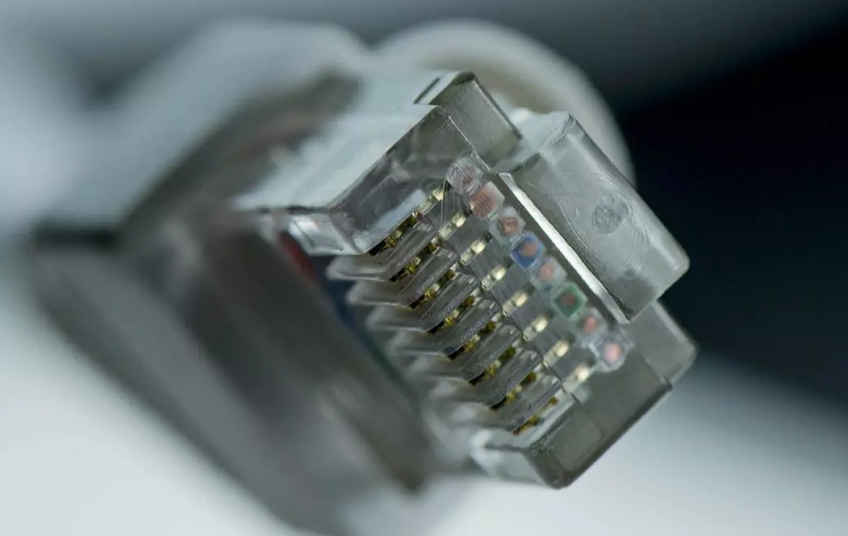We currently have different types of Ethernet network cables on the market to connect our equipment via cable. Depending on the type of network cable, we can achieve a higher or lower speed, because nowadays in-home networks we can have Multigigabit speeds and even up to 10Gbps speeds, this means that we must have specific and quality network cables, of what Otherwise, we will not achieve the expected performance even if the network electronics do. Today in RedesZone we are going to explain in detail the characteristics of the different Ethernet network cables, the types that exist, the categories and more.
What is an Ethernet network cable?
An Ethernet network cable is a cable of several cables twisted pair to pair, with plastic or metallic coatings of different colors and types. An Ethernet network cable has a total of four pairs of twisted two-by-two wires, this means that we will have a total of 8 wires for each network cable. The connector commonly used in these network cables is known as RJ-45, this connector has a total of 8 metal connectors to transfer information through electrical impulses. Any network cable, regardless of type or category, will be terminated in an RJ-45 connector to connect it to a router, switch, PC or any other device that supports the Ethernet standard.
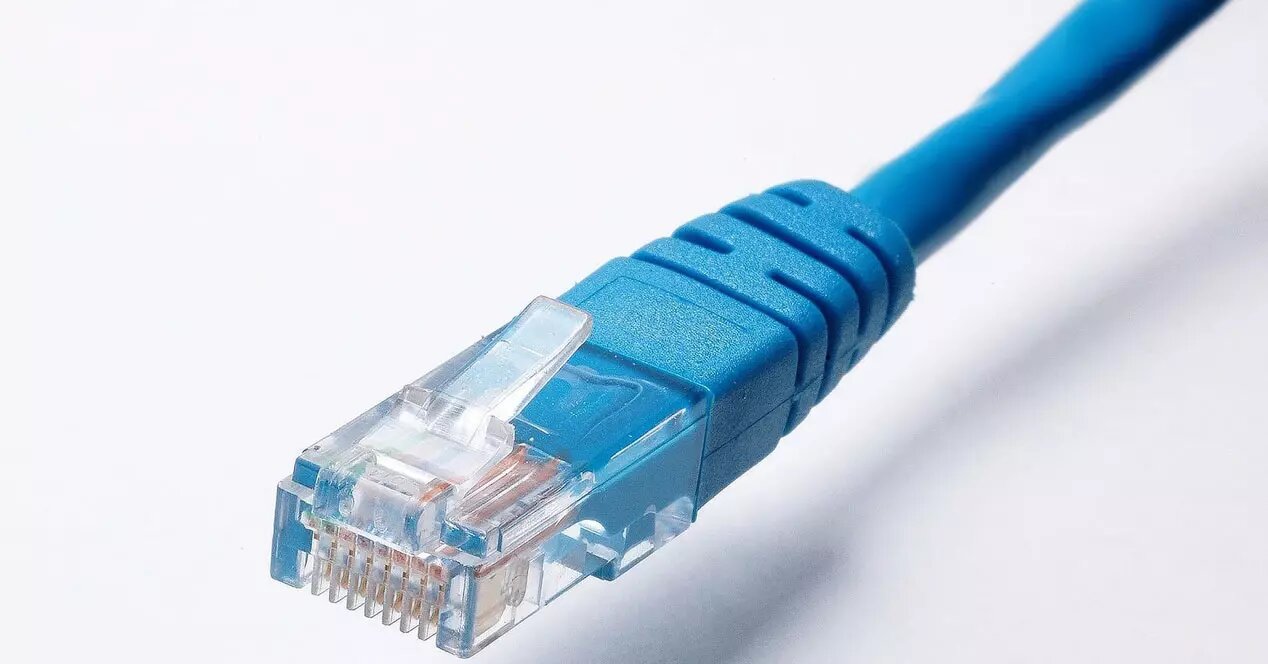
Taking a cable and taking it from the router to the computer is not complicated, however, not all cables are the same or guarantee the same speed. According to the quality and type, network cables are classified into categories that help us to know their characteristics, the speeds that will allow us to achieve and the tolerance to failures or interferences to be able to mount and configure the best network that is used. adapt to our needs and our Internet connection.
Ethernet network cables can be "flat" or "crossover." When we assemble a flat network cable, the configuration that must be made at each end of the network cable is following the 568B standard. In the case of wanting to mount a crossover network cable, at one end of the cable we will crimp it following the 568B color standard, and at the other end we will use the 568A standard. Currently, all network cards, routers, switches and other network equipment support auto MDI / MDIX, this means that the Ethernet standard itself will automatically detect what we have connected and act accordingly by exchanging the internal "pins" of the network cards, therefore, this is to do or buy crossover network cables has already passed into history, it is not at all necessary and everything will work as expected with "flat" network cables, that is.
Within Ethernet network cables, we have a total of four different types of twisted pair, and also different categories. Depending on our needs for speed or distance, we will have to choose one type of network cable or another.
Types of twisted-pair cables
There are a total of four different types of twisted pair cables, depending on the sheathing and sheathing of the cables, these types are UTP, FTP, STP, and S / FTP. We must pay special attention to the differences between them because each of them is specifically oriented to a very different use, logically, the price also varies enormously between the different types of cable, with UTP being the cheapest of all of them and S / FTP the most expensive of them all.
UTP
UTP stands for Unshielded Twisted Pair, or also known as Unshielded Twisted Pair. This type of twisted pair cable does not have any type of shielding, it is the most used in home networks due to its low cost and high performance. This type of twisted pair cable is used for Cat 5, Cat 5e and even Cat 6 cables, therefore, we can achieve speeds of up to 10Gbps in short sections and provided that the network cable is of quality.
These types of network cables produce more errors due to interference or crosstalk than other types of network cables that do not have additional protections. Of course, the maximum distance of this type of network cable is 100 meters as dictated by the standard, however, in real environments, this distance is much less, especially if it is not a stretch of 100 meters in a straight line.

This type of UTP twisted pair cables is what is used in new homes that come with all wired rooms, we must remember that according to the regulations it is necessary that the network cabling has its own macaron and put the cable there, no it is shared with TV cables or light cables, therefore, we should not have too much external interference.
FTP
FTP stands for Foiled Twisted Pair, also known as Global Screen Twisted Pair. In this type of cable, the pairs that are twisted pair by pair are not shielded, but we do have a global screen inside the plastic cover to improve the level of protection against external interference. The transmission characteristics are very similar to UTP, of course the same old RJ-45 connectors are used.

These types of network cables produce fewer errors due to external interference than UTP. Of course, the maximum distance of this type of network cable is 100 meters as dictated by the standard, however, in real environments, this distance is much less, especially if it is not a stretch of 100 meters in a straight line. Depending on the category of the cable, we can achieve a higher speed or a lower speed, for example, there are Cat 6 FTP cables that are ideal to give extra protection to the cabling.
The price of this type of network cable is somewhat more expensive than UTP, however, we think it is worth spending a little more money on better cabling. A recommendation that we are going to give you is that you use shielded RJ-45 connectors, in this way, we will protect not only the network cable but also the connector.
STP
STP stands for Shielded Twisted Pair, or also known as Shielded Twisted Pair. In this type of network cable, the pairs that are twisted pair by pair are covered by a thin sheet of aluminum foil, in order to protect the pairs from possible interferences and also from electrical noise. This type of cable offers a level of protection superior to FTP, however, it is clearly more expensive than UTP and also than FTP.
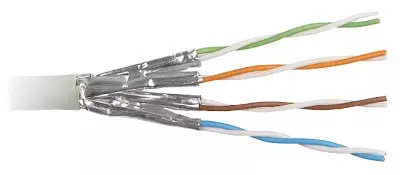
Another characteristics of this type of twisted pair cable are that it is very rigid, which makes it difficult to install in certain scenarios, however, if the needs require it, it is highly recommended, in addition, we must bear in mind that it is quite expensive in compared to UTP, so we must take it into account. Of course, in this type of network cable, the usual typical RJ-45 connectors are also used, when using this type of cable it is recommended that the RJ-45 connectors are also shielded, in order not to lose any signal because of the connector itself.
S/FTP
S/FTP is a combination of the two previous types of cables. On the one hand, we have the twisted pairs shielded two by two, using metallic protections in the pairs of cables, to protect them against possible external electromagnetic interference and reduce noise. We also have a global metal mesh that covers all the twisted pairs, and then we have the typical plastic coating.
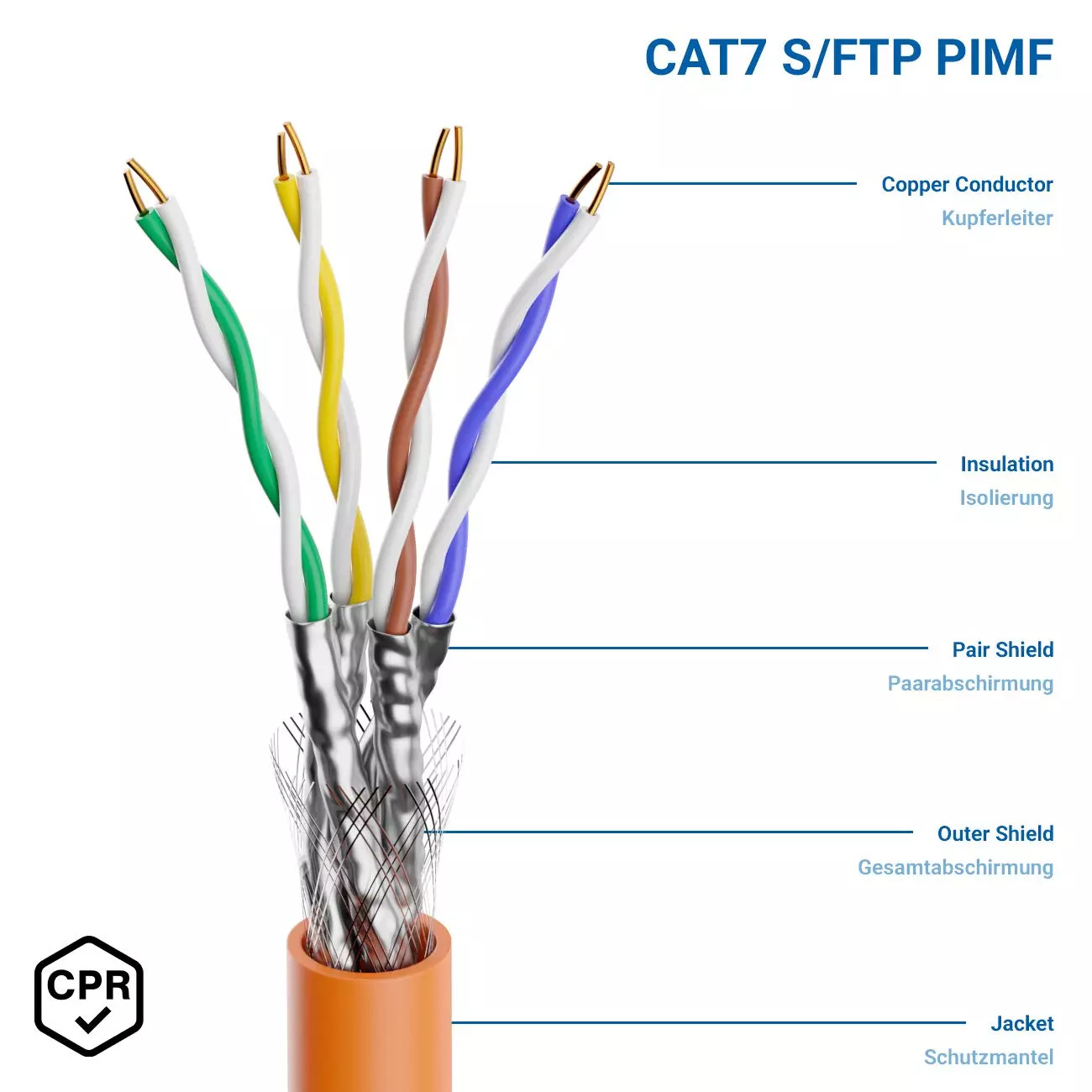
These types of S / FTP cables are the best in terms of protection against interference or external noise, the most rigid due to the multiple built-in protections, and also the most expensive. Cat 7 or higher cables usually always incorporate this type of protection, with the aim of providing a high bandwidth of up to 2000MHz, clearly superior to cables in previous categories and types of cables such as UTP.
Twisted Pair Network Cable Categories
In addition to looking at the type of cable depending on the coating it incorporates, it is very important to look at the type of network cable category. Depending on the category, the level of twisting of the cable will be higher or lower, in addition, in laboratory tests you can see the frequency that it supports to be able to send data at a higher or lower speed. Currently, Cat5 cables are no longer used, however, Cat5e cables (enhanced or enhanced) are what we commonly see in home routers when they incorporate a network cable.
All network cables support a maximum distance of up to 100 meters, this is a limitation imposed by the Ethernet standard itself, not the cable itself. In the following table, you can see the different categories up to Cat 7, the maximum speed that is allowed and the operating frequency of the cable.
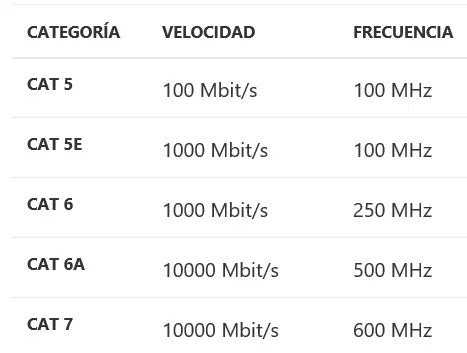
With the launch of the NBASE-T standard, or also known as "Multigigabit", the maximum speeds of the different categories of cables have changed radically. Next, you can see the speeds of the different categories of the most common cables if we have a Multigigabit network.
-
Cat 5e: we can use Cat 5e cables to obtain a maximum speed of up to 2.5Gbps in sections of less than 100 meters, in addition, in ideal conditions (without interference, noise, etc.) it is also possible to achieve the speed of 5Gbps.
-
Cat 6: it will allow us to always obtain a speed of 5Gbps in sections of less than 100 meters. We must remember that Cat 6 cables also allow the 10GBASE-T standard to be used with certain crosstalk and length conditions. When using Cat 6 cables the maximum length is 56m with favorable crosstalk, otherwise the maximum is 37m (if for example several cables are installed together). If Cat 6 cables are used it is recommended that they be electrically tested once installed.
While Cat 6 network cables can be of the UTP, FTP, STP or S / FTP type, we will always have the S / FTP type of Cat 6A or higher network cables, that is, we will have the maximum level of coverage. , with the aim of achieving high frequencies and high wired speeds. Although the standard recognizes that UTP-type Cat6A cables could exist, manufacturers have directly opted for shielded solutions to ensure performance and avoid alien crosstalk. For example, there are Cat 7 cables that have a frequency of 1000MHz, instead of the usual 600MHz, there are also Cat 8 network cables that have a frequency of up to 2000MHz.
What network cable should I use?
In order to answer this question, we must first know what speed we want to achieve, and if we have a Multigigabit network in our home or not, because depending on these requirements, it is better to buy a cable of a certain category or of a certain type than another.
If you are a home user with Gigabit Ethernet equipment and you could switch to Multigigabit networks soon, our recommendation is to buy Cat 6 UTP type cabling, because the price difference with Cat5e is minimal, and you will have a cable that will be capable of providing speeds of up to 10Gbps in short sections. This type of cable is the most recommended and common, in fact, the new homes are wired with this type of network cable and the operation is perfect.
If you are a somewhat more advanced user, with all Multigigabit equipment and even 10G equipment, our recommendation is to use at least Cat6 cables, in addition, it would be advisable to buy Cat 7 cable that has a very good price if we take into account the quality-price, this Cat7 type of cabling will not only provide you with great speed, but it is S / FTP type, therefore, we have the maximum possible protection.
If you are going to wire your house from scratch and run network cable through the different rooms, without a doubt we recommend using Cat 7 cabling because it will guarantee you to have a 10G network without problems in all the rooms.
If you are a very advanced user, who continuously tests switches and NAS servers to check the speed in the local network, and you want to rule out performance problems with the cables, a very good option would be to buy high-performance Cat 8 cables, valid to achieve speeds up to 40Gbps on the local network. Logically, this type of cable is clearly more expensive than the previous ones.
TAs you have seen, today we have different types of twisted pair cables with different categories, in addition, depending on our needs we can choose one cable or another, to avoid wasting money or to avoid problems for not buying the category and suitable type.



